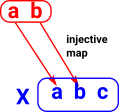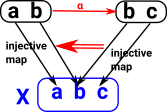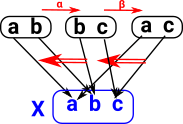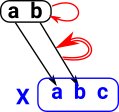| "Comma categories were introduced by Lawvere [1963] in the context of the interdefinabilty of the universal concepts of category theory. The basic idea is the elevation of arrows of one category to objects in another" - Computational Category Theory, D.E. Rydeheard R.M. Burstall. |
Here are some examples of comma categories. In these cases all the objects are in the same category (including the fixed object). The comma category generalises this by allowing the objects to come from other categories.
Arrow categorysee page here |
 |
|
Examples |
Slice categorysee page here |
 |
|
|
Co-slice categorysee page here |
 |
|
Examples |
Slice Category
Given a category C we can 'slice' it over some object X![]() C which we fix in C.
C which we fix in C.
| This construction allows us to start with one category 'C' and generate a different category 'C/X' by fixing a given element 'X' in C. The elements in C/X are pairs (A,P) where A |
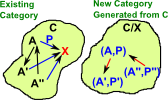 |
'co-slice' is the dual concept, just reverse all the arrows.
Slice Category Examples
On the page here I have put more information about these examples
Colouring of labeled set. Here we choose as our fixed object 'X' the 3 element set containing R, G and B (for red green and blue). Every object (in this case set) has an arrow (function) to this set so all the elements are assigned a colour. |
 |
Adding a distinguished point (the origin) to Euclidean space to give a vector space. |
 |
Comma Category
In the slice category all the objects are in the same category (including the fixed object). The comma category generalises this by allowing the objects to come from other categories. |
 |
Special Cases of Comma Category
We have already seen the slice category, here is a fuller list of special cases and related constructs:
Slice CategoryIf 's' is the identity functor of C and 't' is the inclusion 1 -> C of an object c See ncatlab site. |
 |
Co-slice CategoryLikewise if 't' is the identity and 's' is the inclusion of c, then (t/s) is the coslice category c/C See ncatlab site. |
 |
Arrow CategoryThis is all derived from a single category. So it is a comma category where the arrows into it are identity functions. Unlike the slice or co-slice both the source and target can be somthing other than the terminal object.
|
 |
Graph CategoryThe category of graphs is an example of a comma category, that is, a graph is isomorphic to a comma category. Arrows of graphs are pairs of functions mapping nodes to nodes (N -> N) and edges to edges (E -> E) , an object of this category it a triple (E,f: E -> N×N,N) where f maps each edge to a source and target node. See page here. |
|
Universal Morphism"The notion of a universal morphism to a particular colimit, or from a limit, can be expressed in terms of a comma category. Essentially, we create a category whose objects are cones, and where the limiting cone is a terminal object; then, each universal morphism for the limit is just the morphism to the terminal object. "- academickids.com See page here. |
 |
Adjunction"Lawvere showed that the functors F : C->D and G : D->C are adjoint if and only if the comma categories F See page here. |
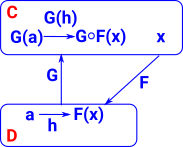 |
Kan ExtensionSee page here. |
Discussion
 |
The comma category is a specialisation of the arrow category where the codomain is the same for all objects. |
| Alternatively there is also a cocomma category where the domain is the same for all objects. | |
 |
The above diagram could be rewritten with the X shown in each object to make it look more like the arrow category. |
The concept of a comma category is related to the idea of a fibre and sheaf, reading these pages for may help with intuition.
Then the comma category C |
The co-comma category X |
||||||||||||||||
Objects |
|||||||||||||||||
pairs(A,f)
|
|
||||||||||||||||
Morphisms |
|||||||||||||||||
|
|
||||||||||||||||
Terminal Objects in Comma |
Initial Objects in Co-Comma |
||||||||||||||||
If C has a terminal object '1' exists then: C/1 = C |
If C has an initial object '0' exists then: 0/C = C |
||||||||||||||||
Products in Comma |
CoProducts in Co-Comma |
||||||||||||||||
In terms of the above 'pairs' we can construct a product:
We can reduce the above diagram to: |
|||||||||||||||||
General Comma Category
 |
The comma category can be generalised further by making the target also a functor. |
Further Genralisation
So we fix f: C->D and X![]() D
D
Then the slice category C/X has, |
The coslice category X/C has, |
||||||||||||||||
Objects |
|||||||||||||||||
|
|
||||||||||||||||
Morphisms |
|||||||||||||||||
|
|
||||||||||||||||
We can generalise this further by not fixing X
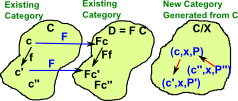
Instead x is combined with the pair to give a triple.
Then the comma category F |
The co-comma category F |
||||||||||||||||
Objects |
|||||||||||||||||
triple(c
|
|
||||||||||||||||
Morphisms |
|||||||||||||||||
|
|||||||||||||||||
Further generalisation, we add a third category 'E' like this:

Then the comma category F |
The co-comma category F |
||||||||
Objects |
|||||||||
|
|||||||||
Morphisms |
|||||||||
|
|||||||||
Comma Category References
- TheCatsters - Youtube - Slice categories 1 Nov 2008
- TheCatsters - Youtube - comma categories 2
- Wiki
- nlab
- Richard Southwell - Universal Properties and Comma Categories - Youtube video - 51 min into video
- Richard Southwell - Adjoint Functors - Youtube video -30 min into video







